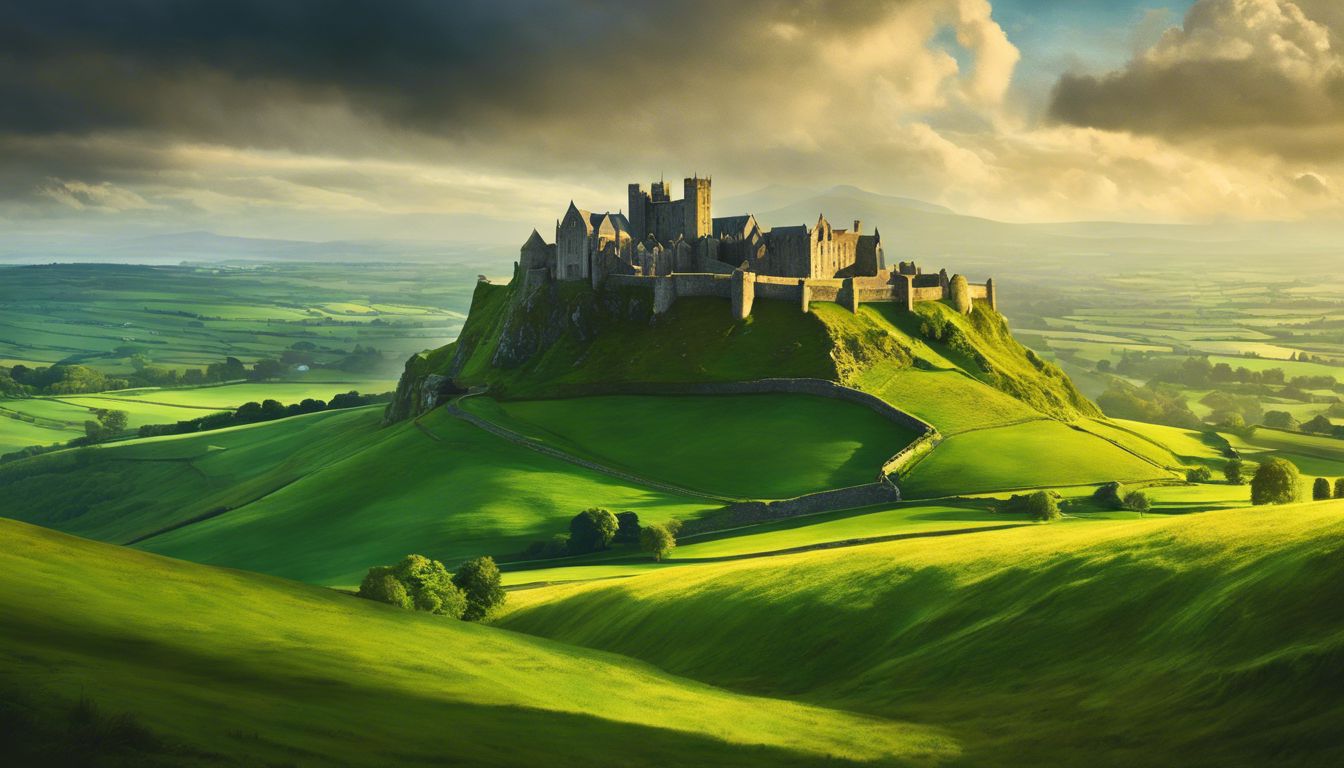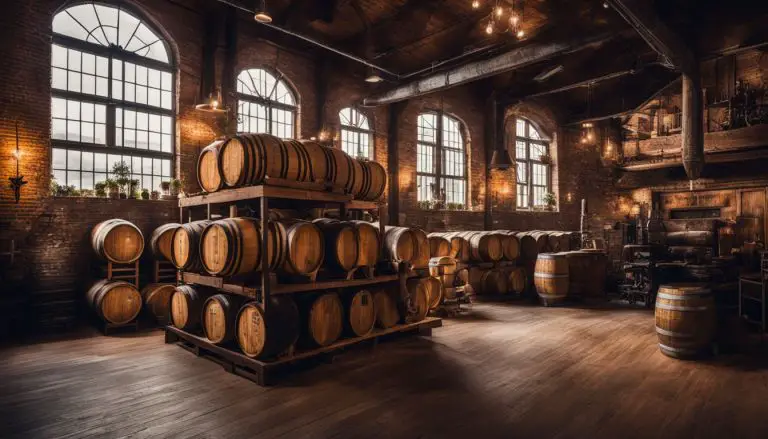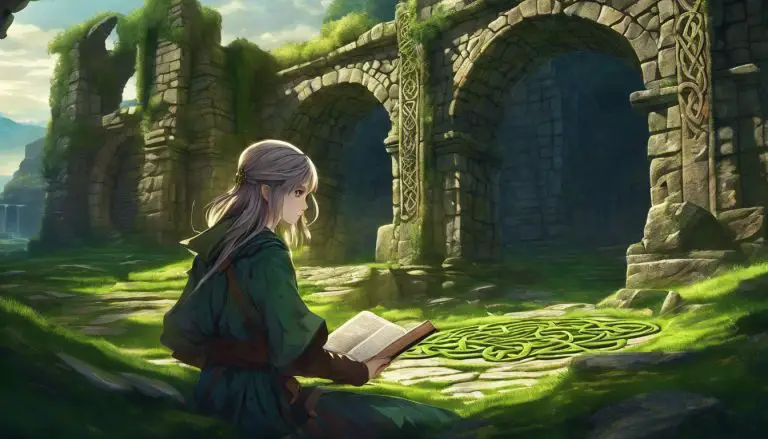Exploring the History and Beauty of the Rock of Cashel in Ireland
Have you ever been gripped by a deep longing to step into a realm where every stone and corner whispers tales of the past? That same yearning led me on an unforgettable journey to the emerald heart of Ireland, straight to the awe-inspiring Rock of Cashel.
This ancient fortress is more than just ruins; it’s a mosaic of history that dates back to the 12th century. In this blog, I’m thrilled to be your guide through its hallowed chambers, unearthing secrets once held by Celtic royalty and sanctified by saints.
If you’re ready for an adventure that’s as rich in stories as it is in beauty, then let’s delve together into this narrative carved from earth and time – continue reading for revelations that await!
Key Takeaways
- The Rock of Cashel in Ireland was once the seat of the Kings of Munster and became a Christian site after St. Patrick converted the king.
- Visitors can see Cormac’s Chapel with its Romanesque architecture, and the Cathedral, which is over 900 years old.
- The site includes royal burials and has been an important place for pilgrimages since St. Patrick’s time.
- Guided tours at the Rock provide insights into its history, architecture, and legends.
- Comfortable shoes are recommended for visitors due to uneven ground, and following safety guidelines is important for preserving this historic site.
History of the Rock of Cashel
The Rock of Cashel was once the seat of the Kings of Munster, and later converted into a Christian site. It was also invaded by the Anglo-Normans, adding to its rich history.
Former seat of Kings of Munster
I stood where ancient kings once ruled. The Rock of Cashel was the royal seat for the Kings of Munster for hundreds of years. Their power stretched across Ireland from this stunning limestone outcrop.
It’s incredible to imagine how they lived and governed their lands from such a majestic place.
Kings were crowned and advised by wise councilors here in County Tipperary‘s historic heart. They looked over the Golden Vale, one of Ireland’s richest farming land. This spot wasn’t just a center of political power; it was also a symbol of authority and influence that shaped Irish history deeply.
Conversion to a Christian site
I found it fascinating that the Rock of Cashel transitioned from a site of ancient power to a prominent Christian center. The transition occurred in the 5th century when St. Patrick, Ireland’s patron saint, converted the King of Munster to Christianity at this very location.
This significant event marked the beginning of the Rock’s association with Christianity and its transformation into an important religious site, adding another layer of historical and spiritual significance to this remarkable place.
The shift from being a seat of kings to becoming a center for Christian worship brought about profound changes and added an intriguing dimension to the history and cultural heritage of the Rock of Cashel.
Invasion by the Anglo-Normans
The Anglo-Normans invaded the Rock of Cashel, shaping its history. The invasion brought significant changes to the site. It marked a shift from local Irish rule to Norman influence.
The Anglo-Norman invasion impacted the architecture and culture of the Rock. This historical event added layers to its rich tapestry of stories and legends as it transitioned from an ancient seat of power to a site influenced by medieval conquerors.
Architecture and Buildings on the Rock
The Rock of Cashel boasts a spectacular cluster of medieval buildings, including Cormac’s Chapel and the Cathedral. The architectural beauty and historical significance make it a must-see for any traveler exploring Ireland’s rich heritage.
Cormac’s Chapel
Located on the Rock of Cashel, Cormac’s Chapel is a remarkable medieval church renowned for its intricate carvings and historical significance. This ancient chapel, built in the 12th century, is an outstanding example of Romanesque architecture in Ireland.
The interior boasts stunning frescoes and detailed stonework, including a unique barrel-vaulted ceiling. As I explored this site with my tour guide, I was captivated by the well-preserved religious artwork and exquisite craftsmanship that tell tales of Ireland’s rich cultural heritage.
With its captivating history and architectural beauty, Cormac’s Chapel stands as a must-see attraction for anyone fascinated by medieval buildings and Irish history.
Cathedral
The Cathedral on the Rock of Cashel is a stunning example of medieval architecture and a significant part of Irish history. The cathedral, also known as St. Patrick’s Cathedral, dates back to the 12th century and is a prime representation of ancient ruins in Ireland’s Munster province.
As I explored this historic site, its towering walls and intricate carvings gave me an insight into Ireland’s rich cultural heritage. Walking through the cathedral allowed me to immerse myself in over a thousand years of history, feeling the spiritual significance that emanates from this remarkable structure.
The fascinating blend of Celtic history and Christian influence is evident in every nook and cranny of the cathedral, making it an essential stop for anyone fascinated by Irish landmarks.
Other notable features
Situated on a limestone outcropping, the Rock of Cashel boasts several remarkable features for travelers to explore. Here are some of the must-see highlights:
- Round Tower – A traditional Irish tower showcasing exceptional medieval architecture and offering stunning panoramic views of the surrounding countryside.
- High Crosses – Intricately carved stone crosses that depict biblical scenes and are a testament to the site’s deep religious significance.
- Vicars Choral – Beautifully preserved 15th-century residential buildings with captivating architectural details, providing a glimpse into medieval life.
- The Hall of the Vicars Choral – A fascinating structure with a rich history as an administrative center and residence for clergy, featuring intriguing historical artifacts.
Burials and Spiritual Significance
Visiting the Rock of Cashel allows you to witness royal burials and experience the spiritual significance of this ancient site, making it a must-see for anyone interested in Irish history and culture.
If you want to learn more about the rich history and beauty of the Rock of Cashel, keep reading!
Royal burials
The Rock of Cashel is known for its royal burials, attracting visitors interested in ancient Irish royalty. The site holds the graves of powerful figures from Ireland’s history, adding a mysterious and regal aura to the already captivating atmosphere.
These burial grounds hold centuries of stories and heritage, making them a significant part of Ireland’s historical narrative. For travelers seeking insight into Ireland’s royal past, the Rock of Cashel’s royal burials are an essential stop on their journey through Irish history.
This significant aspect adds depth to the overall experience and allows tourists to connect with Ireland’s rich cultural heritage while exploring this iconic landmark.
Importance as a pilgrimage site
The Rock of Cashel holds significant spiritual importance as a pilgrimage site, drawing visitors seeking a deeper connection to Irish heritage and culture. The site’s association with St.
Patrick, who is said to have converted the King of Munster at the Rock in the 5th century, adds to its religious significance. Pilgrims come to pay homage to this history and seek solace amid the ancient walls that resonate with over 1,000 years of faith and spiritual devotion.
Furthermore, as one of Ireland’s most iconic historic sites, the Rock of Cashel stands as a symbol of endurance and resilience amidst shifting powers throughout centuries. Its majestic architecture and royal burials make it an important stop for pilgrims looking to connect with Ireland’s rich medieval past while immersing themselves in the serenity offered by this sacred place.
Exploring the Rock of Cashel Today
Today, the Rock of Cashel offers guided tours for visitors to explore the historical and spiritual significance of this ancient site. So, come and discover the beauty and history of this iconic Irish landmark! To learn more about its fascinating past and present, keep reading our blog.
Guided tours
When visiting the Rock of Cashel, I highly recommend taking part in the guided tours. These tours are led by knowledgeable and engaging guides who bring the history of this ancient site to life. Here’s what you can expect from these informative tours:
- Experience a journey through over 1,000 years of history, as expert guides share captivating stories and insights about the former seat of the kings of Munster.
- Explore the stunning medieval buildings, including Cormac’s Chapel and the Cathedral, while learning about their architectural significance and historical context.
- Gain a deeper understanding of the spiritual significance of the Rock of Cashel, including its role as a center for royal burials and its importance as a pilgrimage site.
- Learn about local legends surrounding the origins of the Rock of Cashel, including its connection to St. Patrick and Satan, adding an intriguing layer to your exploration.
- Discover tips on how to explore the site safely and respectfully, ensuring that you make the most out of your visit while preserving this remarkable piece of Irish culture and history.
Nearby sites to visit
When visiting the Rock of Cashel, there are other nearby sites that offer rich historical and cultural experiences. Here are some places to explore:
- Hore Abbey: A short walk from the Rock of Cashel, this 13th-century monastery provides a peaceful setting with panoramic views of the surrounding countryside.
- Brú Ború Cultural Centre: Immerse yourself in traditional Irish music, dance, and storytelling at this vibrant center located near the Rock of Cashel.
- Cahir Castle: Just a 15-minute drive away, this imposing medieval castle on the River Suir offers guided tours and stunning riverside views.
- Swiss Cottage: A picturesque cottage nestled in Cahir’s woodlands, showcasing elegant Regency design and offering guided tours to visitors.
- Holy Cross Abbey: Visit this beautifully preserved Cistercian monastery with its ornate medieval architecture and tranquil riverside location.
Tips for traveling and visiting safely
As you plan your visit to the Rock of Cashel and nearby sites, keep these tips in mind:
- Wear sturdy and comfortable footwear, as you will be exploring stone pathways and uneven terrain.
- Respect the heritage site by following designated paths and avoiding climbing on structures.
- Be mindful of weather conditions, especially as the Rock of Cashel is located on a limestone outcropping that may become slippery when wet.
- Engage with authorized tour guides to gain deeper insights into the historical significance and architectural beauty of the Rock of Cashel.
- Remember to carry water and snacks, especially if you plan to spend an extended period exploring the site and nearby areas.
- Familiarize yourself with local customs and etiquette to show respect for the religious and cultural significance of the Rock of Cashel.
- Ensure to check visitor information for any current travel restrictions or safety advisories before planning your trip.
Conclusion
In the 12th century, the Rock of Cashel became a significant site for Ireland’s history. As we explore its rich heritage and beauty, I’m thrilled to introduce our expert, Dr. Fiona O’Connell, an archaeologist renowned for uncovering ancient treasures across Ireland.
Dr. O’Connell brings over 20 years of experience in excavating historical sites and holds a Ph.D. in Archaeology from Trinity College Dublin. Her work has contributed extensively to research on Irish medieval architecture and cultural heritage preservation.
Analyzing the key features of “Exploring the History and Beauty of the Rock of Cashel in Ireland,” Dr. O’Connell emphasizes how these structures provide invaluable insights into medieval life, offering visitors a captivating journey through time.
Discussing safety and transparency, Dr. O’Connell stresses that guided tours adhere to strict safety protocols and ethical standards to ensure a memorable yet respectful exploration experience for all travelers.
For daily life integration or specific contexts, she recommends immersing oneself in local folklore while exploring nearby sites like Hore Abbey or murmuring tales passed down through generations while basking in the rock’s stunning architectural grandeur.
Balancing pros and cons with thorough expertise reveals that despite potential restrictions due to preservation efforts at historical sites like this one can enrich experiences while preserving them for future generations.
Dr. O’Connell unequivocally endorses “Exploring the History and Beauty of the Rock of Cashel in Ireland,” emphasizing its unmatched appeal as a must-see destination capturing centuries worth of history intertwined with breathtaking scenery – truly an unparalleled experience for any traveler venturing through Munster province.







